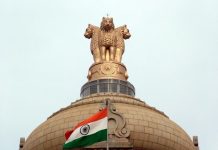This article is written by Ishita Venkata Naga Sai Chinta from Hidayatullah National Law University. This article deals with the procedure for removal of Judges in India with some controversies in the past impeachments.
Table of Contents
Introduction
One of the salient features of the Indian Constitution is the ‘independent and integrated judiciary’. Judiciary’s main function is to apply and elucidate the laws in the country and it is irrefutably the supreme interpreter of the constitution. The theory of ‘Separation of Powers’ by Montesquieu has soundly swayed it way into the constitution bringing the checks and balances between the three main branches of the government i.e., legislative, judiciary and executive and this is how only the parliament has the power to remove any High Court or Supreme Court Judge in our country. A District Court Judge may be removed after the confirmation of the High Court collegium and signed by the Law Minister of the respected state.
Judges and their wide powers
The Indian judiciary follows the motto ‘Yato Dharmastato Jayah’ which means ‘where there is righteousness, there is victory’. Judges are the keepers of law and have enormous powers which come with an extensive amount of responsibility. The three degrees of courts in India are well versed i.e. Supreme Court, High Courts and Subordinate Courts. The Judges in these courts have different levels of jurisdiction. The higher courts overpower the lower courts and set precedents which the lower courts compulsorily comply to. The court’s main function is to safeguard the laws and keep in check whether the government bodies are abiding by the law or not. It also keeps the law supreme authority in the country. The courts have the power to decide the controversies between states inter se and between states and centre. In criminal cases, the judges have full power to decide whether the alleged is guilty of the charges or not, the Judges decide the amount of compensation or jail time of the guilty. Not only this but the courts have the power to declare a law void if they find it unconstitutional.
Grounds of Removal
For the removal of a Supreme Court or High Court judge there are two grounds i.e. incapacity or misbehaviour. These words aren’t defined in the constitution, but the Parliament has enacted the Judges (INQUIRY) ACT, 1968 and the Judges Inquiry Rules, 1969 which sees into the matter, giving a procedure of the investigation. A High Court or Supreme Court Judge is removed in the manner as given in Article 217 (1)(b), Article 124 (4) and (5) of the Constitution. It is not an easy task to remove a Judge from his office, there should be proved incapacity or misbehaviour and proved over here basically means the Judge has been investigated by an impartial Committee first and then presented in the Parliament if said to have fulfilled the two given grounds. In a few cases, the extent of incapacity or misbehaviour may not reach the level where he or she can be removed from his or her office, here the office bearers of the Bar Association or the Chief Justice of the concerned High Court will see into the matter and then submit it to the Chief Justice of India, thereafter he/she will decide what has to be done. In case of a mental or physical incapacity, there would be a medical examination set by the investigation Committee for the Judge.
Procedure of Removal
Any Supreme Court or High Court Judge can only be removed by the Parliament after the President’s signature, whereas a Subordinate Court Judge can be removed by a written complaint to which the collegium looks into, if found guilty then he/she is removed after the Law Minister of the concerned state signs it.
The procedure for removal of a Supreme Court or High Court Judge are:
- A motion can be raised by 100 members of Lok Sabha or 50 members of Rajya Sabha and it would depend upon the Speaker or Chairman to admit or refuse the motion.
- If the Speaker/Chairman admits the motion, he/she would constitute an unbiased Committee consisting of a Supreme Court Judge, a High Court Judge and a renowned Jurist. This Committee can be called the Inquiry Committee, which would investigate the alleged Judge. A copy of charges would be given to the Judge and he/she would be given reasonable opportunity to speak while cross-examining witnesses. But if the Inquiry Committee doesn’t find the Judge guilty of the charges raised against him/her then there would be no future action.
- If the Judge is found guilty by the Committee then the report is put in front of the concerned House of Parliament and future debates take place. One thing to be noted here is that it would depend upon the Parliament to take the motion any further or not. The motion has to pass by a special majority in both the Houses of Parliament then it is addressed to the President for removal.
- Then the President removes the alleged Judge.
Brief Steps for Removal of a Supreme Court or High Court Judge
|
STEP 1: A motion should be raised by at least 100 members of Lok Sabha or 50 members of Rajya Sabha. The motion may be admitted by the Speaker/Chairman or not. If the motion is not admitted by the Speaker/Chairman then there won’t be any future action. |
|
STEP 2: If the motion is admitted then it is the Speaker’s job to set a three-member Inquiry Committee for the investigation against the alleged Judge. The Inquiry Committee will investigate and if it finds out the Judge is not guilty then there won’t be any further actions. |
|
STEP 3: If the Committee finds the Judge guilty then it would submit its report to the concerned House of Parliament. If the House is dissolved then there won’t be any further action. |
|
STEP 4: If the motion is passed by one House and then by both the Houses, then the removal is addressed to the President. |
|
STEP 5: The President then removes the Judge. |
Laws applicable in removing a Judge
Article 124(2)(b) of the Constitution: It says that a Supreme Court or High Court Judge may be removed in the manner given in the clause (4) of the article.
Article 124(4) of the Constitution: It says that a Judge of the Supreme Court shall not be removed from his office except by an order of the President passed after an address by each House of Parliament supported by a majority of the total membership of that House and by a majority of not less than two-thirds of the members of that House present and voting has been presented to the President in the same session for such removal on the ground of proved misbehaviour or incapacity.
Article 124(5) of the Constitution: It says that Parliament may by law regulate the procedure for the presentation of an address and for the investigation and proof of the misbehaviour or incapacity of a Judge under clause (4).
Article 217(1)(b) of the Constitution: It says that a Judge may be removed from his office by the President in the manner provided in clause (4) of Article 124 for the removal of a Judge of the Supreme Court.
Judges (Inquiry) Act, 1968 consists of laws relating to the procedure of the investigation, powers of the Inquiry Committee, the report of the Inquiry Committee and how this report would be addressed to the concerned House of the Parliament.
Judges Inquiry Rules, 1969 This act is basically like an extra hand to the Judges (Inquiry) Act, 1968, as it talks about procedure of removal, the investigation and the Inquiry Committee and etc.
Comparison with Other Countries
England: In India, it requires a special majority in both the Houses of Parliament whereas in England there is no such majority specified. In India, there are specified grounds on which a Judge can be removed whereas there are no specifications mentioned in England and in India, there are provisions for investigation of the Judge whereas there are no such provisions in England.
United States: In India, the grounds on which the Judges are removed are incapacity or misbehaviour but in the US it is the judicial misconduct by which a Judge can be removed. After the motion is passed in both the Houses by the two-third majority then it is addressed to the Governor for removal of the Judge whereas in India it is addressed to the President. As the feature ‘independent judiciary’ has been adopted from The States, it has similarities to our country.
Switzerland: In India, the grounds on which the Judges are removed are incapacity or misbehaviour but in Switzerland, Judges are removed on the basis of misconduct or incapability. A Judicial Committee is set up for the investigation of the Judge and it submits a report to the Federal Assembly which may or may not remove the Judge, it depends on the Assembly.
Russia: In Russia, the Supreme Court Judge is removed on the grounds of non-performance or undue performance in his/her official work according to the country’s federal Constitutional laws or does anything against the laws of the country, whereas we know in India it is incapacity or misbehaviour.
Canada: In Canada, the Canadian Judicial council investigates the alleged federally appointed Judge for misconduct. After investigating, the Council may recommend the Minister of Justice for the removal of the alleged Judge. The minister then gets the approval of both the Houses i.e. House of Commons and Senate before he removes the Judge.
Famous cases of Removal of Judges in India
No Judge till date has been removed in India, there have been attempts to remove Judges in India.
The first attempt for removal of a Judge in India was made on 12th March 1991, against the Supreme Court Judge v. Ramaswami for financial irregularities, when the Speaker of Lok Sabha admitted the motion, there was an Inquiry Committee set up, comprising Justice P.B. Sawant, a sitting Supreme court Judge, Chief Justice Desai of Bombay High Court and Mr. Chinnappa Reddy an ex-Supreme Court Judge as a jurist, this three-member unbiased Committee was investigating the Judge according to the Judges (Inquiry) Act, 1968, but before it could submit the report the Lok Sabha was dissolved.
P.D. Dhinakaran was the Chief Justice of Sikkim High Court, earlier he was the Chief Justice of Madras High Court, he was under investigation by the Judicial Committee because of which he was transferred to Sikkim High Court. He was charged for land grab and abuse of judicial office. But he resigned in the year 2011 before any action could’ve been taken against him.
Soumitra Sen was a Justice of Calcutta High Court, he was charged for misappropriating 33.2 lakhs under his custody. He was removed by the Rajya Sabha but he tendered his resignation in the year 2011 so that he could still have the post-retirement privileges.
J.B. Paridawala was a Justice of Gujarat High Court, he was charged for giving objectionable remarks on the reservation. The Justice was sent an impeachment notice by the Parliamentarians because of which he took back his remarks. After the removal of remarks, the impeachment was squashed.
C.V. Nagarjuna Reddy was a Justice of Andhra Pradesh High Court, the Rajya Sabha tried to impeach him twice but failed. He was accused of victimising a Dalit junior Civil Court Judge, interfering in judicial processes and caste slurs.
Conclusion
Judges are known for their adroitness towards their work as they are the moderators of disputes, and the nation relies upon them for justice. Judiciary is one of the most important elements of the society because of the increasing amount of crimes in the country, it is a ray of hope for justice. Removal of Judges is a rigid process in India and that is for a reason so that the powerful authorities won’t misuse power to remove a concerned Judge. We know that Judiciary is integrated and independent in India but only the Parliament can remove any Judge from his/her office, this is because of the checks and balances in our country, and it is indeed a very important element so that no one between the legislative, executive and judiciary feel omnipotent about the powers they have.
LawSikho has created a telegram group for exchanging legal knowledge, referrals and various opportunities. You can click on this link and join:
https://t.me/joinchat/J_0YrBa4IBSHdpuTfQO_sA
Follow us on Instagram and subscribe to our YouTube channel for more amazing legal content.














Very informative article
To eradicate corruption in judiciary, the process for impeachment of judges should be made more flexible!